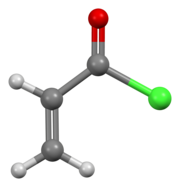Acryloyl chloride

| |

| |
| Names | |
|---|---|
| Preferred IUPAC name
Prop-2-enoyl chloride | |
| Other names
2-Propenoyl chloride
| |
| Identifiers | |
3D model (
JSmol ) |
|
| ChemSpider | |
ECHA InfoCard
|
100.011.272 |
PubChem CID
|
|
| UNII | |
CompTox Dashboard (EPA)
|
|
| |
| |
| Properties | |
| C3H3ClO | |
| Molar mass | 90.51 g·mol−1 |
| Density | 1.119 g/cm3 |
| Boiling point | 75.0 °C (167.0 °F; 348.1 K) |
| Hazards | |
| GHS labelling: | |
  
| |
| Danger | |
| H225, H302, H314, H330 | |
| P210, P280, P301+P330+P331, P303+P361+P353, P305+P351+P338, P310 | |
| Flash point | −4 °C (25 °F; 269 K) |
Except where otherwise noted, data are given for materials in their standard state (at 25 °C [77 °F], 100 kPa).
| |
Acryloyl chloride, also known as 2-propenoyl chloride, acrylyl chloride, or acrylic acid chloride, is the
Preparation
Acryloyl chloride can be efficiently prepared by treating acrylic acid with benzoyl chloride:[2]
- CH2=CHCO2H + C6H5COCl → CH2=CHCOCl + C6H5CO2H
Conventional phosphorus-based chlorinating agents, e.g. phosphorus trichloride, are ineffective. Flow conditions allows use of a broadened range of chlorinating agents including oxalyl chloride and thionyl chloride.[1] [3]
Reactions
This compound undergoes the reactions common for acid chlorides. For example, it reacts readily with
Acryloyl chloride is most commonly employed for the introduction of acrylic groups into other compounds, e.g. the preparation of acrylate monomers and polymers.[5]
Toxicity
Acryloyl chloride, like volatile acid chlorides, is a skin irritant, with pulmonary edema in more severe exposures.[6] Other signs and symptoms of acute exposure may include headache, dizziness, and weakness. Gastrointestinal effects may include nausea, vomiting, diarrhea, and stomach ulceration.[7]
References
- ^ a b PatentStorm LLC (2006). "Process for the manufacture of acryloyl chloride". PatentStorm LLC. Archived from the original on January 14, 2013. Retrieved December 21, 2007.
- .
- PMID 27325562.
- doi:10.15227/orgsyn.067.0098.)
{{cite journal}}: CS1 maint: multiple names: authors list (link - ISBN 978-3527306732.
- S2CID 251779499. Retrieved 8 April 2023.
- ^ "ACRYLYL CHLORIDE | CAMEO Chemicals | NOAA".
See also
- Methacryloyl chloride
- List of extremely hazardous substances
